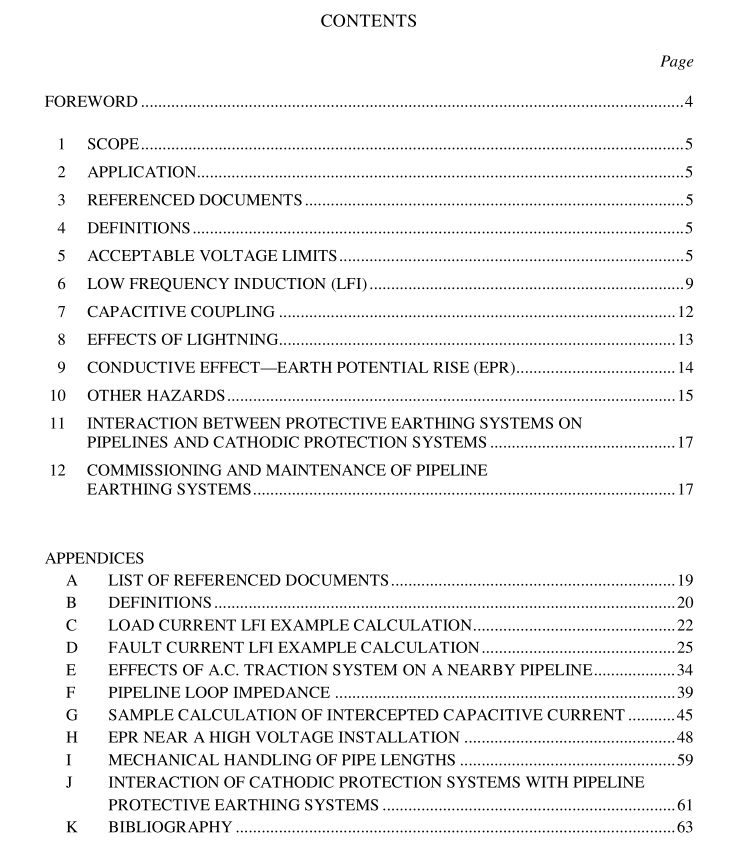AS NZS 4853 pdf download – Electrical hazards on metallic pipelines

AS NZS 4853 pdf download – Electrical hazards on metallic pipelines
1 SCOPE
This Standard specifies voltage limits and corresponding time constraints acceptable on both underground and above-ground pipelines that may be subject to power system influences. Guidance on the mitigation of lightning flash attachments is also provided.
NOTE: The acceptable voltage and time limits are based on the conditions outlined in AS 3859. This Standard describes the mechanisms which create hazardous electrical conditions on such pipelines and provides guidance on how to calculate and mitigate these hazards. This Standard does not cover electrical hazards on electricity power plant associated with the construction of pipelines and their coatings. Such hazards are covered by AS/NZS 3000 and its associated Standards.
2 APPLICATION This Standard is applicable to those pipelines with electrically conducting walls, usually steel, and with an aqueous slurry or hydrocarbon-based product content such as water, oil or gas. The responsibility for the application of this Standard rests with the owner or operating authority of the pipeline and therefore they should seek competent advice with regards to its content. It is not intended that this Standard be applied retrospectively to installations existing at the date of publication of this Standard in so far as design, construction, operation, maintenance and testing are concerned. However, this Standard may be used during redesign or upgrading of existing pipelines to achieve conformance.
3 REFERENCED DOCUMENTS The documents referred to in this Standard are listed in Appendix A.
4 DEFINITIONS For the purpose of this Standard the definitions listed in Appendix B apply.
5 ACCEPTABLE VOLTAGE LIMITS
5.1 General This Clause 5 sets out requirements for two categories of acceptable voltage limits for pipelines. Requirements for Category A touch voltage limits are provided in Clause 5.3. Requirements for Category B touch voltage limits are provided in Clause 5.4.
NOTES:
1 The voltage limits are touch voltage limits as defined in this Standard.
2 Pipelines which have touch voltages above those given in Clause 5.4 are outside the scope of this Standard. Some indication of the nature of such voltages is provided in Clause 5.5.
3 Reference in other documents to the acceptable voltage limits given in this Standard may be achieved by the wording ‘Category A (or Category B) touch voltage limits in accordance with AS/NZS 4853 (this Standard)’ as appropriate.
4 There is a misconception that internationally agreed power and telecommunication induction and earth potential rise (EPR) limits are applicable generally to environmental safety. These limits are as follows:
(a) Voltage withstand for pulse conditions of affected telecommunications equipment is relatively high (≈ 1500 V).
(b) Low risk conditions in telecommunications terminals — clear, dry, insulated floors and very small contact areas.
(c) Very low coincident exposure (based on statistical analysis).
(d) Minute cost to telecom carriers to fit exposed circuits with gas tube protectors, which are often required to protect against lightning surges. Combined with high resistance circuits (50 – 1000 ohm), these offer high protection. These items are not applicable to pipeline technology.
5.2 Risk assessment Acceptable Category
A maximum touch voltage limits for accessible pipelines are given in Table 5.3. The voltages relate to electrical safety protection from electric shock. However, Category A touch voltage limits may be unnecessarily onerous on pipelines with totally restricted public access (e.g. high pressure gas transmission lines) and a risk assessment should be made to determine whether Category B touch voltage limits (Clause 5.4 and Table 5.4) may be permitted.
NOTE: Guidance on risk management is given in AS/NZS 4360. Whilst the major point of the risk assessment is to determine the acceptability of Category B touch voltage limits, attention is drawn to the need for a risk assessment also for some aspects of installations with Category A touch voltage limits. The risk assessment shall be in two parts; one for pipelines accessible by the general public and the other for pipelines only accessible to authorized persons. The risk assessment shall include the following:









